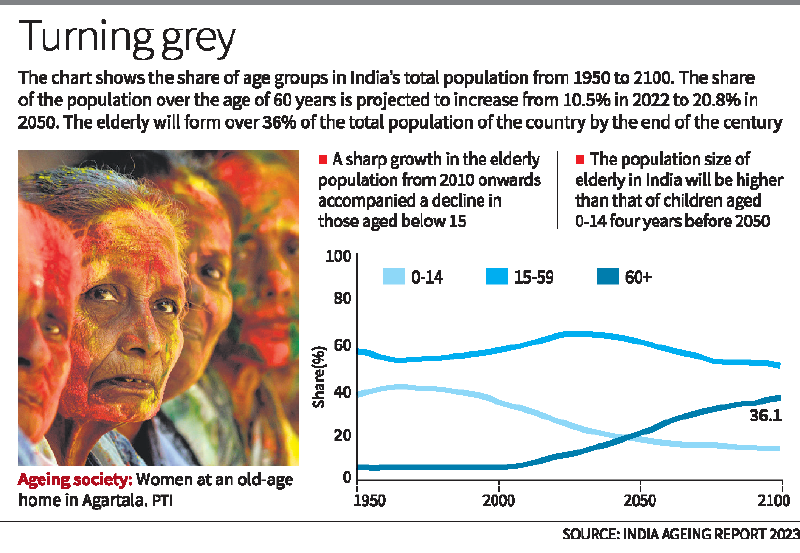Description

Disclaimer: Copyright infringement not intended.
Context
- The United Nations Population Fund (UNFPA) released a report in 2023, titled the "India Ageing Report," which highlights the significant demographic shift India is experiencing with an increasingly ageing population.
Details
Key findings and implications of the report
Rapid Growth of Elderly Population
- The report estimates a decadal growth rate of 41% for the elderly population in India.
- It predicts that by 2050, the elderly population will make up over 20% of India's total population.
- By 2046, it is expected that the elderly population will surpass the population of children aged up to 15.
Economic Challenges
- More than 40% of India's elderly population is in the poorest wealth quintile, and around 18.7% of them live without any income.
- This high level of poverty among the elderly can negatively impact their quality of life and their ability to access healthcare services.
Gender Disparities
- The report highlights gender disparities in life expectancy among the elderly.
- Women, on average, have a higher life expectancy at the ages of 60 and 80 compared to men.
- This is a trend seen across several states and union territories in India.

Regional Variations
- There are significant regional variations in the absolute levels and growth of the elderly population.
- States in the southern region and select northern states like Himachal Pradesh and Punjab report a higher share of the elderly population than the national average.
- In contrast, states with higher fertility rates and slower demographic transitions like Bihar and Uttar Pradesh will see an increase in the share of the elderly population but at a lower level than the national average.
Feminization and Ruralization of Elderly Population
- The report notes that major challenges facing India's ageing population include the feminization (a higher proportion of elderly women) and ruralization (concentration of elderly population in rural areas) of this demographic group.
- This calls for policies tailored to meet the specific needs of elderly women, who are more likely to be widowed, living alone, and dependent on family support.
Sex Ratio Among the Elderly
- The sex ratio (number of females per 1,000 males) among the elderly has been steadily increasing since 1991, indicating that women tend to outlive men in this age group.
- However, there are regional variations in this trend, with some areas still having more elderly men than women.
Old Age Dependency Ratios
- Different regions of India have varying old age dependency ratios, with the southern and western regions having higher ratios compared to central and northeastern regions.
- This reflects differences in the pace of demographic transition across states.
Global Ageing Trend
- The report also notes that increasing life expectancy and declining fertility rates are contributing to a global trend of ageing populations.
- This trend is not unique to India but is observed worldwide, which will have implications for countries across the globe.
Gender Ratio among the Elderly
- The gender ratio among the elderly is changing, with an increasing number of elderly women compared to men.
- This trend is expected to continue, with a projected increase in the number of elderly women relative to men by 2031.
.jpg)
Conclusion
India is undergoing a significant demographic shift with a rapidly growing elderly population, which is expected to make up a substantial portion of the total population by 2050. This demographic change poses economic and social challenges, particularly for elderly women and those living in poverty. Policymakers will need to address these challenges and develop policies that cater to the specific needs of this ageing population.
MUST READ ARTICLES:
https://www.iasgyan.in/daily-current-affairs/ageing-population-in-india#:~:text=In%20the%202011%20census%2C%20the,to%20319%20million%20in%202050.
|
PRACTICE QUESTION
Q. India is undergoing a rapid demographic shift with a growing elderly population. Discuss the key findings and implications of the India Ageing Report 2023 released by the International Institute for Population Sciences and the United Nations Population Fund. How should India formulate policies to address the challenges posed by this demographic transition, particularly in relation to gender disparities and rural-ageing? (250 Words)
|














